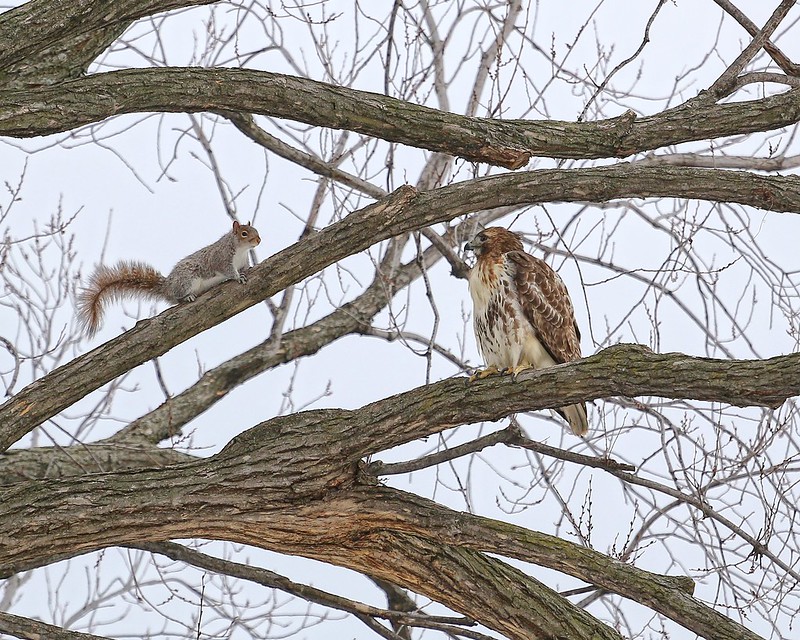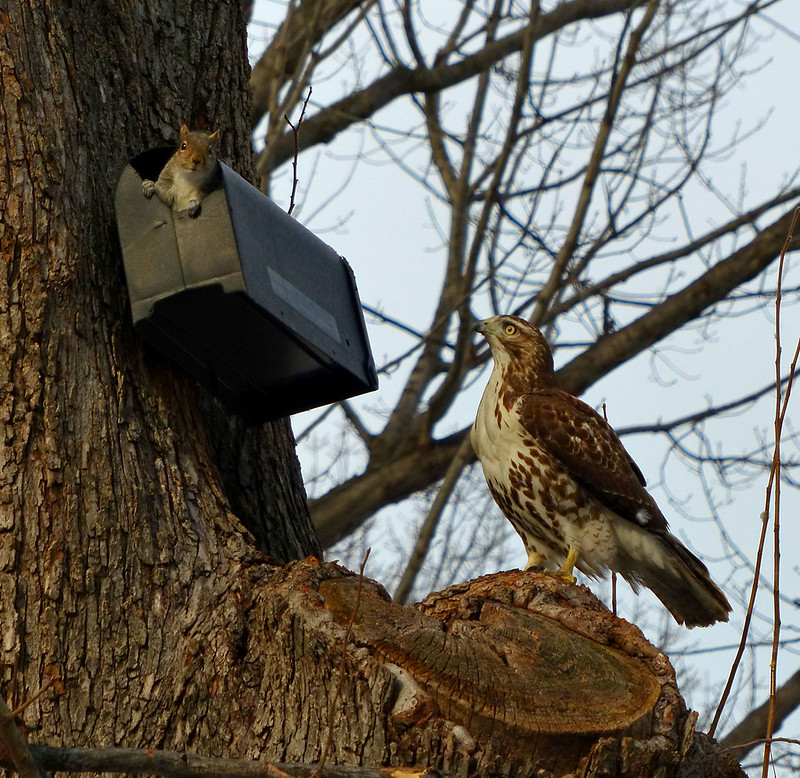This raptor-rodent interaction has been on display recently as the fledgling hawks are learning to hunt prey. Below, two of the three hawk siblings met up in a tree on the center lawn on a recent morning.

The tree, however, was already occupied by a squirrel, who was not happy to see these two on its property. The squirrels are extremely territorial and will confront the hawks when they land in their tree. As I see it, the squirrels own the trees and the hawks merely borrow them from time to time.

The young hawks are obviously interested in this squirrel, and I love seeing how they study its every move.

What these photos do not convey is the sound the squirrel was making. If you're walking through the park and hear this alarm call, that is a squirrel alerting to the presence of a hawk. Look around and you are almost guaranteed to find a hawk nearby. The squirrels make several other sounds, but this one is specific to the danger of a predator. I don't know if it specifically means "hawk" or is a general predator warning, but in Tompkins Square Park, the hawks are the only predator that upsets the squirrels.
About six weeks ago, dad Christo showed his kids how to catch a squirrel, and they've been trying ever since, but the squirrels have been too quick and wily, easily escaping the young hawks. Most confrontations end with the hawk giving up and leaving the tree.

On a recent morning, one of the fledglings was being much more patient, allowing a bold squirrel to get very close.


I watched this scene for about 30 minutes as the squirrel kept approaching the hawk, running away, then approaching again. From this very low perch about two feet off the ground, the hawk could see all the squirrels running around under the bushes, and this squirrel definitely did not like the hawk sitting there in its territory.

While this was happening, one of the other fledglings was directly above in a tree with another squirrel.

The squirrel seemed confident enough to turn its back on the hawk. Does it know the hawk can't catch it (yet)?

The hawk never takes its eyes off the squirrel.

The squirrels we have here in the city are Eastern Gray Squirrels. They come in a variety of colors (gray, blonde, dark brown, two-tone brown), and I recently found this interesting study that explains that some of them have black coats due to inbreeding with Fox Squirrels, who range across the southeastern US. The original paper can be found here.
Adult squirrels weigh 400-600 grams, or just over a pound. The hawks weigh anywhere from 1.5 to 3.5 lbs. For reference, Dora weighed 3.15 lbs when she was picked up by WINORR back in April 2018. Christo is smaller than Dora, Amelia is larger than Dora, and the fledglings appear to be somewhere in between.
For the hawks to catch and carry a squirrel means lifting almost half their body weight, which takes strength. To accomplish this, the young hawks have been practicing with inanimate objects like this substantial branch (below).

We've seen fledglings in the past struggle to lift and carry off heavy prey, like this hawk who barely managed to clear a fence with a big rat and drag it down Avenue B in 2014. The youngsters seem to go for the most difficult prey first, like the squirrels and large rats, and eventually settle for things they can manage like smaller rats and mice.
Hawk-squirrel confrontations are nothing new in Tompkins Square, as we've been observing them over the last several years. Diving into the archives, I found this photo of a fledgling hawk checking out a squirrel in 2018:

This is Christo staring down a squirrel in 2018. As the hawks and squirrels all co-exist in the same small area of the park, I imagine they are all familiar with each other and, as Christo is a top-notch hunter, you can bet the squirrels don't like him at all.

Another fledgling hawk faces off with a squirrel in 2017:

If the squirrel is upside-down, you have to look at it upside-down! (2017)

Christo (2017):

Fledgling (2016):

Another fledgling (2016):

Dora (2015):

Fledgling (2014):

Christo (2014) - if you look closely, you can see the feet of another squirrel sticking out below Christo on the right. Even seeing that one of its kindred was caught, this squirrel still challenges the hawk.

The squirrels are masters of maneuvering through the trees and they are not easy prey for the hawks. If a squirrel is on top of a branch, it can escape in nearly any direction. When I've seen Christo successfully catch one, he usually does it by grabbing it from the side of a tree, as demonstrated below in 2014. The two squirrels were together on the trunk of the tree when Christo came swooping in from around the corner and snatched one of them.

Although the hawks are able to catch the squirrels, they prefer prey like rats, pigeons and mice. The squirrels seem to know this, and rarely display fear of the hawks, although they do sound the alarm when one is around. The squirrels in Tompkins Square are well-fed, healthy, strong and have a courageous attitude that I think is unique to the park. I love that we have this unique opportunity to observe these wildlife interactions in this urban environment.

Immature red-tailed hawk and a squirrel in Tompkins Square Park (2014).
There are lots of black squirrels in Stuy-Town!
ReplyDelete